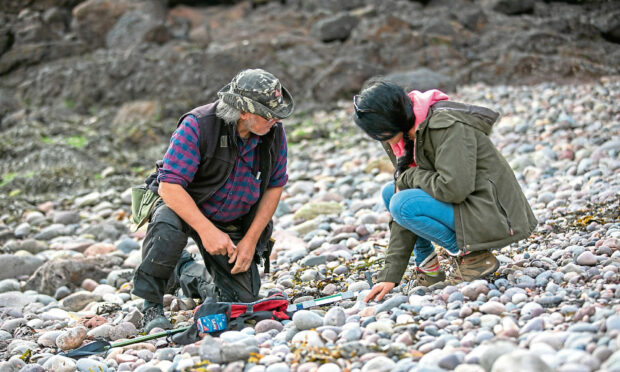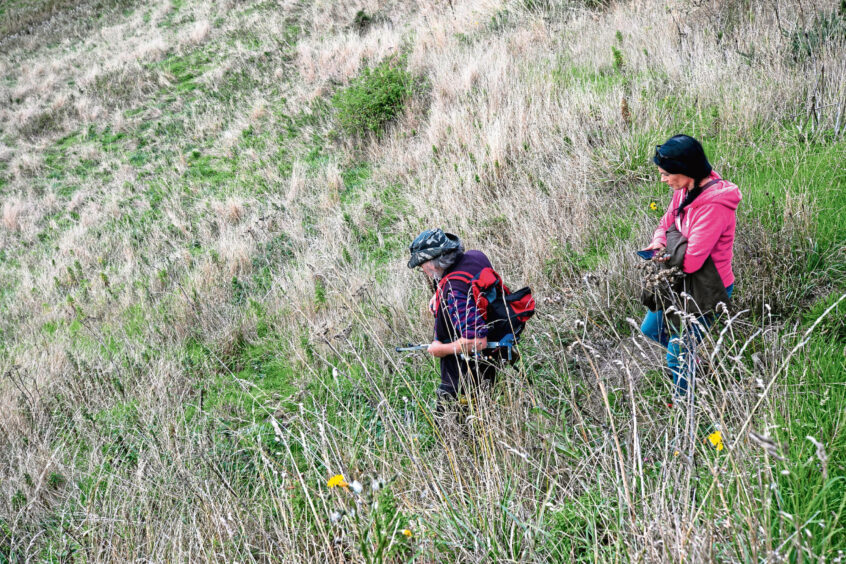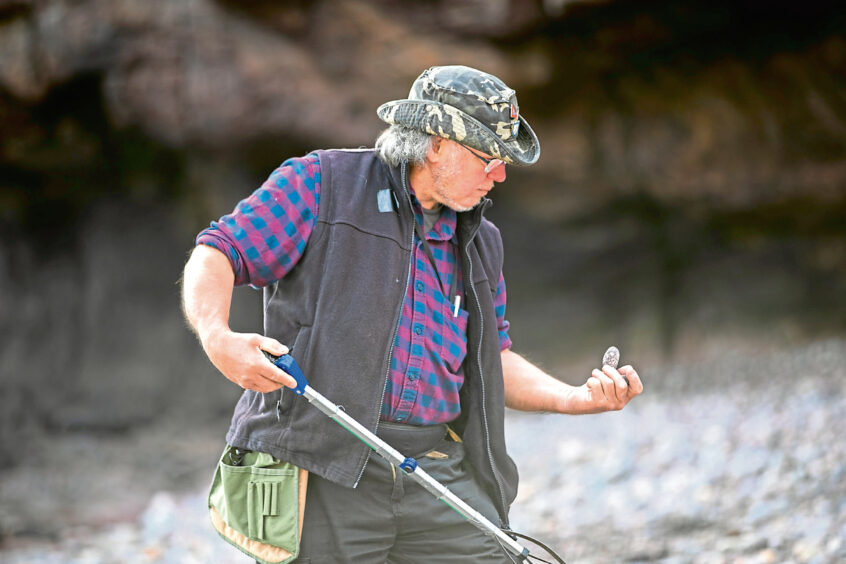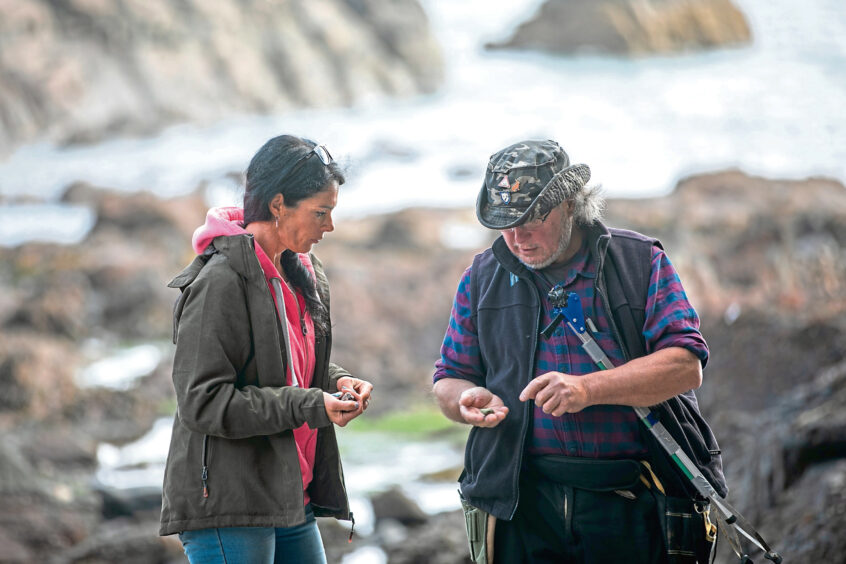The Scottish Geology Festival runs until October 9, with events across the country to unlock the stories of our planet’s past. Gayle heads out to hunt for agates in Angus.
Some human beings are a bit like magpies – naturally draw to shiny objects.
Rock hunters, mineral collectors, jewellers, crafters and general hoarders of beautiful things very often delight at the stunning spectacle that is the agate stone.
The most striking specimens can resemble miniature landscape paintings, with translucent layers of colours and detail as delicate and seemingly deliberate as brushstrokes.
Primarily formed in the holes of volcanic rocks known as basalt which filled with deposits of silica bubbling up from the earth’s depths and crystallised in layers, the stone is distinguished by impressive shades of natural colours and ‘banding’.
Scottish Geology Festival
With the 2022 Scottish Geology Festival in full force, it’s a brilliant time to hunt for agates, with advice on how and where to find them. I hooked up with John Taylor, a volunteer with the Scottish Geology Trust who’s keen to show me what the Angus coastline has to offer.
The sandstone ‘conglomerate’ cliffs were formed by a giant Mississippi-sized river that flowed over vast parts of the land more than 370 million years ago.
That’s why the beaches here are peppered with eroded cobbles and pebbles, and they all have a great story to tell, from erupting volcanoes to colliding continents.
Retired NHS manager John, 71 suggests we head to Elephant Rock, near Boddin Point, to see what we can find.
Before we set off he shows me some of his collection, stashed into boxes in the back of his van.
My jaw drops as I gaze upon pebbles, rocks and stones in all colours, shapes and sizes. The most incredible, an agate, is one John almost discarded.
Incredible agate
He’d picked it up as a chunk of lava “with no particular features” at Elephant Rock and then threw it away, thinking it “wasn’t that great”.
However, something drew him back to look for it and he stuffed it into his pocket.
Back at Leith Lapidary Club (lapidary is the cutting, polishing and engraving of stones), John skimmed the flattest side of the rock with a saw – and was blown away by what he revealed.
“It looked like a perfect Scottish landscape agate with its own story,” he recalls.
“I could make out a foreground shoreline, and what looked like the Firth of Forth backed by the Pentland Hills, along with a slightly cloudy sky and in the middle distance the Forth rail bridge. It was a lucky find, lucky retrieval and lucky cut.”
It’s such a rare object and while hopeful I’ll find a few agates (we’re at the exact spot John found this treasure), I’m trying not to raise my expectations too much.
Pleasant walk
The walk down to the beach is pleasant, along a grassy track, round the edges of a stubble field, and down a steep pathway.
Within seconds, John is grabbing at stones with his ‘picker’.
He finds a chunk of celadonite, stunning pieces of banded agate, spotted rhyolite, solid carnelian agate, Boddin Point jasper, and numerous bits of quartz.
It looked like a perfect Scottish landscape agate with its own story. I could make out a foreground shoreline, and what looked like the Firth of Forth backed by the Pentland Hills, along with a slightly cloudy sky and in the middle distance the Forth rail bridge. It was a lucky find, lucky retrieval and lucky cut.”
“You often get these orange exterior ones,” he enthuses. “Occasionally you’ll get an amethyst centre, but sometimes it can turn into smoky or clear quartz.
“You also get ‘waterline’ agates, but if you cut across this you might find you’ve a picture inside.”
I pick up a couple of stones that appeal to me, although I’ve no idea what they are.
“Those are definitely agates – I’ll cut and polish them for you,” promises John.
His advice is to collect when the sun is low and there’s moisture in the air so you’ll see the colour in the stones.
History
“Around 400 million years ago the landscape here would have been largely arid like the Australian desert, with flash floods,” he explains.
“There’d have been no trees or land animals, and Scotland would’ve been landlocked, with no coast at all.
“The cobble stones are a huge range of volcanic, sedimentary and metamorphic rocks, eroded from formations millions of years older. Some are difficult to identify but have fantastic patterns and colours.
“The ‘more recent’ 350 million year old volcanic intrusions into the sandstone like Elephant Rock and the cliffs and underlying rock of Lunan Bay have gas bubbles in the lava which can be infilled over very long periods of time with silica to form agates in many different colours and patterns.”
More questions than answers
Every time John visits a beach he finds a rock that throws up more questions than answers.
“I wonder how they form, how old they are. Sometimes different types weld into each other in unexpected ways. I love the questions. I’m not too bothered if I don’t get answers. It keeps you wondering and speculating.”
Rock hunter
John’s been a rock hunter since he was a young lad growing up on a farm in Norfolk where he was surrounded by flint and fossils.
“My first collection, which I’ve still got in a box, started when I was four years old,” he beams.
He’s since found rocks all over the world, and makes frequent trips to Germany and New Zealand to give talks and show specimens.
- The Scottish Geology Festival runs until October 9, with events, talks, fossil hunts, and even a boat trip on the programme.
- Director Dr Katie Strang says: “From volcanic eruptions to tropical coal swamps, dinosaurs to earthquakes – the rocks beneath our feet provide endless opportunities for adventure, education and discovery.” scottishgeologytrust.org/festival/
- The Scottish Geology Trust was founded in February 2021, with the aim of inspiring people to understand, love and care for Scotland’s incredible geological heritage and its role in creating a sustainable future.

















